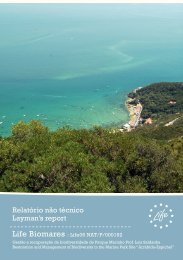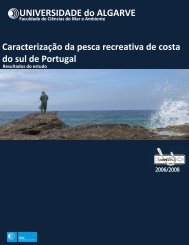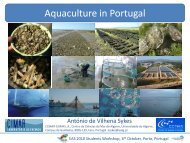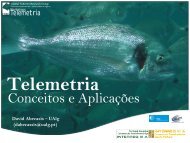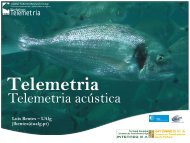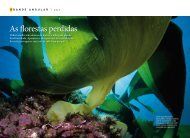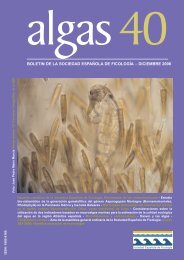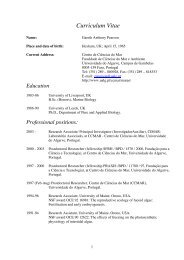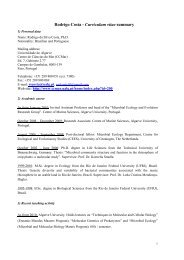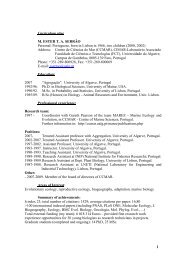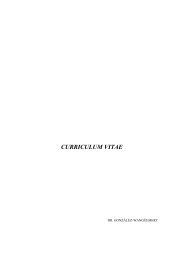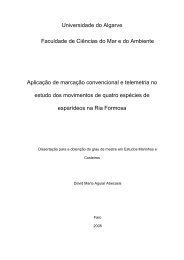genomic dna isolation from green and brown algae - CCMAR ...
genomic dna isolation from green and brown algae - CCMAR ...
genomic dna isolation from green and brown algae - CCMAR ...
You also want an ePaper? Increase the reach of your titles
YUMPU automatically turns print PDFs into web optimized ePapers that Google loves.
J. Phycol. 42, 741–745 (2006)<br />
r 2006 by the Phycological Society of America<br />
DOI: 10.1111/j.1529-8817.2006.00218.x<br />
NOTE<br />
GENOMIC DNA ISOLATION FROM GREEN AND BROWN ALGAE (CAULERPALES AND<br />
FUCALES) FOR MICROSATELLITE LIBRARY CONSTRUCTION 1<br />
Elena Varela-Álvarez<br />
<strong>CCMAR</strong>, CIMAR – Laboratório Associado, FCMA, Universidade do Algarve, Gambelas, 8005, 139, Faro, Portugal<br />
Nikos Andreakis<br />
Stazione Zoologica ‘A. Dohrn’, Laboratorio di Ecologia del Benthos, 80077 Ischia (Napoli), Italy<br />
Asunción Lago-Lestón, Gareth A. Pearson 2 , Ester A. Serrão<br />
<strong>CCMAR</strong>, CIMAR – Laboratório Associado, FCMA, Universidade do Algarve, Gambelas, 8005, 139, Faro, Portugal<br />
Gabriele Procaccini<br />
Stazione Zoologica ‘A. Dohrn’, Laboratorio di Ecologia del Benthos, 80077 Ischia (Napoli), Italy<br />
Carlos M. Duarte <strong>and</strong> Nuria Marbá<br />
Instituto Mediterráneo de Estudios Avanzados (IMEDEA), Consejo superior de investigaciones científicas (CSIC), Esporles,<br />
Palma de Mallorca, Spain<br />
A method for isolating high-quality DNA is presented<br />
for the <strong>green</strong> <strong>algae</strong> Caulerpa sp. (C. racemosa,<br />
C. prolifera, <strong>and</strong> C. taxifolia) <strong>and</strong> the <strong>brown</strong> alga<br />
Sargassum muticum. These are introduced, <strong>and</strong> invasive<br />
species in Europe, except for the native<br />
C. prolifera. Previous methods of extraction, using<br />
cetyl trimethyl ammonium bromide or various commercial<br />
kits, were used to isolate <strong>genomic</strong> DNA but<br />
either no DNA or DNA of very low quality was<br />
obtained. Genomic libraries were attempted with<br />
Caulerpa sp. on three occasions <strong>and</strong> either the<br />
restriction enzyme, the Taq polymerase, or the T4<br />
ligase was inhibited, probably by the large amount<br />
of polysaccharides in these <strong>algae</strong>. The method<br />
presented here consists of the rapid <strong>isolation</strong> of<br />
stable nuclei, followed by DNA extraction. Yields of<br />
6–10 lg <strong>genomic</strong> DNA <strong>from</strong> 1 g fresh blades were<br />
obtained. After <strong>genomic</strong> DNA was isolated <strong>from</strong><br />
fresh material, the quality was checked by agarose<br />
gel. Quantification of DNA concentration was performed<br />
using UV spectrophotometric measurement<br />
of the A260/A280 ratio. The DNA was suitable for<br />
PCR, cloning, <strong>and</strong> hybridization. The DNA isolated<br />
using this method allowed successful construction<br />
of microsatellite libraries for Caulerpa species <strong>and</strong><br />
S. muticum. The technique is inexpensive <strong>and</strong> appropriate<br />
for the <strong>isolation</strong> of multiple samples of<br />
DNA <strong>from</strong> a small amount of fresh material.<br />
1 Received 23 September 2005. Accepted 14 February 2006.<br />
2 Author for correspondence: e-mail g.pearson@ualg.pt.<br />
741<br />
Key index words: <strong>algae</strong>; Caulerpa; CTAB; DNA<br />
extraction; microsatellite; nuclei <strong>isolation</strong>; population<br />
genetics; Sargassum; seaweed<br />
The <strong>isolation</strong> of high-molecular-weight DNA that is<br />
suitable for the construction of microsatellite libraries or<br />
in any <strong>genomic</strong> library <strong>and</strong> in general for digestion with<br />
restriction endonucleases, cloning, hybridization, PCR<br />
amplification can represent a serious problem in many<br />
organisms. The <strong>isolation</strong> of DNA <strong>from</strong> plants <strong>and</strong> <strong>algae</strong><br />
is quite difficult (Doyle <strong>and</strong> Doyle, 1987). Furthermore,<br />
a procedure that works with one a plant or an algal<br />
group will often fail with others, probably because of<br />
the diversity of cell wall, storage, <strong>and</strong> secondary compounds<br />
(Doyle <strong>and</strong> Doyle, 1990), complicating the<br />
preparation of nucleic acids <strong>from</strong> specific groups of<br />
these organisms. Many of these compounds inhibit<br />
down-stream enzymatic reactions (Huang et al. 2000).<br />
The extraction of DNA <strong>from</strong> seaweed cells that are<br />
heavily embedded in sulfated polysaccharides (cell<br />
walls <strong>and</strong> intercellular matrix) is complicated <strong>and</strong><br />
time consuming. Most of the published methods for<br />
DNA extraction <strong>from</strong> <strong>green</strong> <strong>algae</strong> (Meusnier et al.<br />
2004), red <strong>algae</strong> (Hong et al. 1997, Waittier et al.<br />
2000), <strong>and</strong> <strong>brown</strong> <strong>algae</strong> (Phillips et al. 2001) require<br />
grinding tissues in liquid nitrogen. Viscous soluble<br />
polysaccharides are released by grinding algal material<br />
in liquid nitrogen (Brasch et al. 1981) that are difficult<br />
to separate <strong>from</strong> the DNA, therefore cetyl trimethyl<br />
ammonium bromide (CTAB) treatments (e.g. Fawley<br />
<strong>and</strong> Fawley 2004), cesium chloride (CsCl)-gradient<br />
ultracentrifugation (La Claire et al. 1997, Phillips
742<br />
et al. 2001), or lithium chloride (LiCl) (Hong et al.<br />
1992, 1997) methods have been applied during DNA<br />
extraction.<br />
Caulerpales are <strong>green</strong> <strong>algae</strong> that have been<br />
shown to act as invasive species in the Mediterranean,<br />
where two exotic Caulerpa species, Caulerpa taxifolia (M.<br />
Vahl) C. Agardh <strong>and</strong> Caulerpa racemosa (Forsska˚l) J.<br />
Agardh (migrant <strong>from</strong> the Red Sea, de Villèle <strong>and</strong><br />
Verlaque, 1995), have spread into areas formerly<br />
occupied by seagrasses. Caulerpa prolifera (Forsska˚l)<br />
J.V. Lamouroux is a worldwide Caulerpa species <strong>and</strong><br />
it is the only indigenous Caulerpa sp. in European<br />
coasts. Sargassum muticum (Yendo) Fensholt is an invasive<br />
<strong>brown</strong> alga that has been introduced in Europe<br />
<strong>from</strong> Japan <strong>and</strong> presently ranges <strong>from</strong> the Mediterranean<br />
to Norway (Verlaque 2001). More than 100<br />
nuclear rDNA_ITS sequences <strong>from</strong> C. taxifolia <strong>and</strong><br />
other Caulerpa species, as well as for Sargassum species,<br />
are available <strong>from</strong> GenBank. These sequences have<br />
proven valuable in clarifying phylogenies <strong>and</strong> identifying<br />
some biogeographical divisions (Famà et al. 2002,<br />
Stiger et al. 2003, Meusnier et al. 2004). Previous<br />
attempts to study the population genetic diversity of<br />
Caulerpa species have failed because the molecular<br />
markers used were not polymorphic enough to assess<br />
the level <strong>and</strong> spatial pattern of genetic variability<br />
efficiently among populations. In order to design<br />
new markers, the construction of libraries with highquality<br />
<strong>genomic</strong> DNA for these invasive species was<br />
being undertaken.<br />
The coenocytic nature (multinucleate) of the <strong>green</strong><br />
<strong>algae</strong> Caulerpa makes extraction of their DNA more<br />
difficult. Isolation using st<strong>and</strong>ard methods (CTAB,<br />
LiCl, commercial kits, etc) either failed, or the DNA<br />
was of poor quality or very degraded. With the above<br />
methods, inhibition of the restriction, polymerase, or<br />
ligase enzymes occurred when attempting to construct<br />
libraries. Moreover, the small size of the nuclei <strong>and</strong> the<br />
absence of internal cell walls (Caulerpa sp. is composed<br />
of giant cells) imply the use of an average of 4–5 g of<br />
material for obtaining 0.2–0.3 mg of DNA. Finally, some<br />
of the available methods (e.g. CsCl long-term gradient<br />
centrifugation) are costly.<br />
We devised a new approach to extract DNA in<br />
recalcitrant <strong>algae</strong> consisting in rapid <strong>isolation</strong> of nuclei,<br />
followed by DNA extraction. Isolation of stable nuclei<br />
was based on the method of Triboush et al. (1998) to<br />
isolate chloroplast <strong>and</strong> mitochondria in sunflower<br />
seedlings. The following protocol is inexpensive, reproducible,<br />
<strong>and</strong> can be used for extraction of <strong>genomic</strong><br />
DNA for microsatellite library construction.<br />
TABLE 1. Seaweed species used in this study.<br />
ELENA VARELA-ÁLVAREZ ET AL.<br />
Algal material. The species used in this study were<br />
collected at Mallorca (Spain), Algarve (Portugal), <strong>and</strong><br />
Gulf of Naples (Italy) (Table 1). The method was first<br />
developed for three species of Caulerpa (C. taxifolia,<br />
C. racemosa, <strong>and</strong>C. prolifera) <strong>and</strong>thenitwastestedin<br />
S. muticum. Seaweed samples were collected in the<br />
field <strong>and</strong> were held at 41 C for a few days before DNA<br />
<strong>isolation</strong>.<br />
Isolation of nuclei. 4 to 10 g of fresh material was<br />
homogenized in the mortar with 50 mL STE buffer<br />
(400 mM sucrose, 50 mM Tris pH 7.8, 20 mM EDTA-<br />
Na2, 0.2% bovine serum albumin, 0.2% b-mercaptoethanol,<br />
<strong>and</strong> the last two components were added<br />
just before the start of the experiment). The homogenate<br />
was filtered through a 50–55 mm nylonmesh,<br />
closing the mesh to form a bag <strong>and</strong> squeezing by<br />
h<strong>and</strong> to extract the liquid. The extract was centrifuged<br />
at 1000 rpm for 20–30 min. The supernatant<br />
was discarded <strong>and</strong> the nuclei pellet was collected.<br />
DNA <strong>isolation</strong> procedure. Approximately 500 mL<br />
CTAB buffer (2% CTAB, 2% polyvinylpyrrolidone,<br />
1.4M NaCl, 20mM EDTA pH 8.0, 100mM Tris<br />
HCl pH 8.0) was added to the large <strong>green</strong> nuclei<br />
pellets. The sample was heated in a water bath or<br />
thermoblock at 651 C for approximately 1 h. One<br />
volume of chloroform–isoamyl alcohol (24:1) was<br />
added to the sample <strong>and</strong> mixed by inversion for<br />
10min <strong>and</strong> then centrifuged for 30min at<br />
13,200 rpm. The aqueous phase was collected into a<br />
clean microcentrifuge tube <strong>and</strong> the rest was<br />
discarded. Two volumes of absolute ethanol were<br />
added with 0.1 volume (approximately 50 mL) of<br />
sodium acetate 3 M pH 5.2 <strong>and</strong> mixed gently.<br />
Thesamplewasleftforatleast20minat 201 C<br />
<strong>and</strong> afterwards centrifuged for 30 min at 13,200 rpm.<br />
The supernatant was discarded <strong>and</strong> the pellet<br />
was washed in 70% ethanol <strong>and</strong> dried at room temperature.<br />
The pellet was dissolved in 10–50 mL of<br />
purewaterorTE(1 ) buffer (1 mM Tris HCl pH<br />
8.0, 0.1 mM EDTA pH 8.0). After <strong>genomic</strong> DNA<br />
was isolated <strong>from</strong> fresh material, the quality <strong>and</strong><br />
the size of DNA were checked by agarose gel against<br />
a known molecular marker (Fig. 1). Quantification<br />
of DNA concentration was performed by spectrophotometric<br />
measurement of UV absorbance<br />
(Table 2).<br />
Construction of the <strong>genomic</strong> libraries. DNA was<br />
digested with the restriction enzyme AfaI, <strong>and</strong> ligated<br />
to adaptors Rsa21 (5 0 -TCTTGCTTACGCGTGGACTA-<br />
3) <strong>and</strong> Rsa25 (5 0 -TAGTCCACGCGTAAGCAAGAG-<br />
CACA-3 0 ) with T4 Ligase (Promega, Madison, WI,<br />
Species Location Date Material<br />
Caulerpa prolifera Mallorca, Spain 15 May 2004 Fresh thalli<br />
C. taxifolia Mallorca, Spain 15 May 2004 Fresh thalli<br />
C. racemosa Naples, Italy 15 September 2005 Fresh thalli<br />
Sargassum muticum Algarve, Portugal 20 August 2004 Fresh thalli
DNA ISOLATION FROM ALGAE FOR MICROSATELLITE LIBRARY 743<br />
FIG. 1. Electrophoresis analysis (0.8% agarose gel in 10 TAE buffer (40 mM Tris acetate, 2 mM EDTA)) of (a) three r<strong>and</strong>om<br />
samples of Caulerpa prolifera <strong>genomic</strong> DNA extracted with the procedure developed here. Samples were collected in (1) Mallorca, (2)<br />
Menorca, <strong>and</strong> (3) Cabrera, Balearic Isl<strong>and</strong>, Spain. (b) C. racemosa DNA digested with three endonucleases (RsaI, AluI, <strong>and</strong> HaeIII)<br />
according to the manufacturer’s instructions, (c) PCR amplification screening of 96 clones of C. prolifera with possible dinucleotide<br />
microsatellites. The PCR reactions were performed in 20 mL reaction volume containing buffer 10 , dNTPs (2 mM), MgCl 2 (50 mM),<br />
universal primers SP6 (5 0 -CATTTAGGTGACACTATAG-3 0 ) <strong>and</strong> T7 (5 0 TAATACGACTCACTATAGGG-3 0 ) (10 mM), 0.3 U of Taq<br />
polymerase, <strong>and</strong> approximately 5–10 ng of template DNA. The reaction conditions were as follows: 941 C for 3 min, followed by 30<br />
cycles (941 C for 45 s, 501 C for 45 s, <strong>and</strong> 721 C for 45 s) <strong>and</strong> then a 3 min final extension at 721 C. 100 L: 100 bp DNA ladder (Fermentas,<br />
Ontario, Canada), l III L: DNA digested with HindIII Ladder.<br />
USA). The DNA fragments were then purified with<br />
the high-purification kit for PCR products (Amersham<br />
Biosciences, Piscataway, NJ, USA) <strong>and</strong> were successfully<br />
amplified by PCR using both adaptors as primers.<br />
An enrichment method using the MagneSphere s<br />
magnetic separation kit (Promega) was then performed<br />
to select fragments containing a microsatellite motif<br />
among all the DNA fragments contained in the library<br />
following the procedure of Waldbieser (1995). This<br />
procedure was performed for one motif, (CT) 15, with<br />
the corresponding 5 0 -biotinylated <strong>and</strong> 3 0 -ddC probe for<br />
C. prolifera, C.taxifolia, <strong>and</strong> S. muticum libraries. For<br />
C. racemosa, three motifs were used: (CA) 15, (GA) 15,<br />
<strong>and</strong> (TA) 15 (all with the corresponding 5 0 -biotinylated<br />
<strong>and</strong> 3 0 -ddC probe). Selected fragments were ligated<br />
into pGemT-easy vector (Promega) <strong>and</strong> then transformed<br />
into competent Escherichia coli cells (DH5-a)<br />
following the manufacturer’s protocol. Bacteria colonies<br />
were incubated on Petri dishes in Luria–Bertani<br />
(LB) agar with ampicillin (100 mg/mL) at 371 C overnight.<br />
Recombinant colonies were picked <strong>and</strong> grown<br />
in LB medium with ampicillin (100 mg/mL), iso-<br />
propyl b-D-thiogalactopyranoside (IPTG) (0.1 M),<br />
<strong>and</strong> 5-bromo-4-chloro-5-indolyl-b-D-galactopyranoside<br />
(X-Gal) (50 mg/mL) at 371 C for at least 4 h in 96-well<br />
plates. Next, 30% of pure glycerol was added <strong>and</strong> plates<br />
were stored at 801 Casstocks.<br />
Screening of the libraries. Denatured <strong>and</strong> diluted<br />
bacteria were used as templates for PCR with plasmid<br />
primers SP6 (5 0 -CATTTAGGTGACACTATAG-3 0 )<br />
<strong>and</strong> T7 (5 0 TAATACGACTCACTATAGGG-3). The<br />
PCR reactions were performed in a 20 mL volume<br />
containing buffer (10 ), dNTPs (2 mM), MgCl 2<br />
(50 mM), universal primers SP6 <strong>and</strong> T7 (10 mM),<br />
0.3 U of Taq polymerase, <strong>and</strong> approximately 5–<br />
10 ng of template DNA. The reaction conditions<br />
were as follows: 941 C for 3 min, followed by 30 cycles<br />
(941 C for 45 s, 501 C for 45 s, <strong>and</strong> 721 C for 45 s), <strong>and</strong><br />
then a 3 min final extension at 721 C (Fig. 1). The<br />
PCR products were then dot-blotted on a nylon<br />
membrane <strong>and</strong> DNA was hybridized (Rapid Hyb,<br />
Amersham Biosciences, Buckinghamshire, UK) with<br />
a g- 32 P-labeled microsatellite probe. Positive clones<br />
were selected <strong>and</strong> grown in LB agar with ampicillin<br />
TABLE 2. DNA quantification in r<strong>and</strong>om samples of DNA when applying our new method for Caulerpa taxifolia, C. racemosa,<br />
<strong>and</strong> Sargassum muticum.<br />
A 260 A 260/A 280 Purity Concentration (mg/mL)<br />
Amount of DNA extracted<br />
per gram of fresh<br />
weight (mg/g FW)<br />
C. taxifolia 0.221 1.684 84% 0.206 10.3<br />
C. taxifolia 0.204 1.636 81% 0.175 8.75<br />
C. racemosa 0.161 1.75 87% 0.161 6.8<br />
S. muticum 0.226 1.657 82% 0.199 9.95
744<br />
(100 mg/mL) overnight <strong>and</strong> then sent for miniprep<br />
preparation <strong>and</strong> sequencing (Macrogen, Seoul,<br />
Korea).<br />
The DNA extracted with this method was of high<br />
molecular weight with no sign of degradation (Fig. 1).<br />
The yield was in the range of 6–10 mg DNA <strong>from</strong> 1 g of<br />
fresh material (Table 2). The procedure did not require<br />
gradient centrifugation (sucrose, percol), or<br />
ultracentrifugation (CsCl). There were two critical<br />
factors in this protocol.<br />
The first one was the recovery of the nuclei pellets,<br />
which depends on the speed <strong>and</strong> length of the centrifugation<br />
step, as well as the separation of the nuclei<br />
<strong>from</strong> cell debris <strong>and</strong> endosymbiotic bacteria associated<br />
with these <strong>algae</strong>. The second critical factor was the use<br />
of sodium acetate added to the DNA before precipitation.<br />
In this last step, sodium acetate was used instead<br />
of NaCl to avoid residual salt problems, which could<br />
inhibit DNA ligase (Sambrook et al. 1989).<br />
The DNA was perfectly suitable for digestion with<br />
restriction enzymes (such as RsaI, AluI, HaeIII), PCR,<br />
cloning, hybridization, <strong>and</strong> other molecular techniques<br />
used in the construction of the microsatellite libraries<br />
(Figs. 1, a <strong>and</strong> b). In all cases, the efficiency of the<br />
transformation was very high, with more than 80% of<br />
the bacteria containing inserts. The four libraries were<br />
constructed successfully <strong>and</strong> microsatellites were found<br />
in each library following the methods described previously.<br />
An average of 6–10 mg of <strong>genomic</strong> DNA was<br />
used per library.<br />
Before radioactive hybridization, PCR amplification<br />
with plasmid primers (SP6 <strong>and</strong> T7) of cloned inserts<br />
yielded PCR products of 150–900 bp (Fig. 1c). Hybridization<br />
experiments indicated a varying proportion of<br />
positive clones within the four libraries. For C. prolifera,<br />
a total of 960 clones were screened, resulting in 214<br />
positive clones. In C. taxifolia, of 768 screened clones,<br />
only 23 gave a positive signal <strong>and</strong> for C. racemosa, 120<br />
positive clones were found. In contrast, in S. muticum,<br />
672 clones were screened <strong>and</strong> 382 were positive. After<br />
sequencing, the number of microsatellites found in the<br />
four species was different, <strong>and</strong> Sargassum had the<br />
highest number. In total, 92 microsatellites have been<br />
found (30 perfect dinucleotide repeats, 30 compound<br />
dinucleotide repeats, nine trinucleotide repeats, two<br />
tetranucleotide, <strong>and</strong> one pentanucleotide). The length<br />
of the microsatellites varied <strong>from</strong> 6 to 24 repeats.<br />
There are several published studies on the phylogeny<br />
<strong>and</strong> the biogeography of Caulerpa sp. (Verlaque<br />
et al. 2003, Meusnier et al. 2004). All these previous<br />
studies used DNA extraction protocols (mostly using<br />
the CTAB method) that produced DNA of good<br />
enough quality for PCR amplification; however, we<br />
found that the quality of DNA was not good enough<br />
for <strong>genomic</strong> library construction. In general, there are<br />
several valuable methods in the literature for seaweed<br />
DNA extractions, but for some algal taxa these methods<br />
yield DNA that is not useful for PCR amplification<br />
or restriction enzyme digestion. For example, Hong<br />
et al. (1992) developed a simple method using LiCl for<br />
ELENA VARELA-ÁLVAREZ ET AL.<br />
TABLE 3. Repeat units found in clones <strong>from</strong> Caulerpa<br />
prolifera libraries.<br />
(GA) 21, (TC) 18, (TC) 8, (TC) 9, (AG) 24, (GA) 6, (GA) 6,A 12(TA) 5,<br />
(GA)6(AA(GA)2)AAG(AA(GA)2)<br />
the rapid extraction of seaweed nucleic acids suitable<br />
for PCR analysis. However, the LiCl protocol did not<br />
work in the same way in all the tested species. Hong<br />
et al. (1997) found that DNA extracted <strong>from</strong> most<br />
seaweed species by the LiCl method were of sufficient<br />
quality to be used as a template for PCR amplification,<br />
with the exception of DNAs <strong>from</strong> a few species, which<br />
yielded large quantities of DNA, but did not show any<br />
PCR product, probably due to the presence of inhibitors<br />
of the DNA polymerase. Jin et al. (1997) tested 70<br />
species of <strong>brown</strong>, red, <strong>and</strong> <strong>green</strong> <strong>algae</strong> for PCR<br />
inhibitors. Species such as Colpomenia bullosa (Saunders)<br />
Yamada, Sargassum thunbergii (Mertens ex Roth)<br />
Kuntze, Symphyocladia latiuscula (Harvey) Yamada, <strong>and</strong><br />
Ulva sp. showed very high inhibitory activity in PCR<br />
reactions. This inhibitory activity by cytosolic inhibitors<br />
in PCR reactions in DNA extracts of seaweeds has been<br />
associated with antiviral <strong>and</strong> antitumor effects (Kim<br />
et al. 1997, Cann et al. 2000, Eitsuka <strong>and</strong> Nakagawa,<br />
2004).<br />
Before the new method was developed, we tried to<br />
construct a microsatellite library in the three species of<br />
Caulerpa, three times without success, using all the<br />
DNA extraction protocols mentioned above. With the<br />
method developed here, DNA <strong>from</strong> these species <strong>and</strong><br />
S. muticum is now suitable for cloning, sequencing,<br />
hybridization probe technology, <strong>and</strong>, consequently,<br />
for <strong>genomic</strong> library construction.<br />
Table 3 shows the dinucleotide repetitions found<br />
among positive clones sequenced <strong>from</strong> the microsatellite-enriched<br />
<strong>genomic</strong> library in C. prolifera. This information<br />
will be useful to design new molecular<br />
markers for population genetic studies of all these<br />
species.<br />
In conclusion, the protocol presented is highly<br />
recommended for seaweed DNA extractions. The<br />
procedure is a combination of two modified protocols<br />
developed previously by Triboush et al. (1998) for<br />
nuclei <strong>isolation</strong>, <strong>and</strong> by Doyle <strong>and</strong> Doyle (1990) for<br />
DNA <strong>isolation</strong> in l<strong>and</strong> plants. The procedure is rapid,<br />
requires few solutions, <strong>and</strong> is effective in isolating<br />
<strong>genomic</strong> DNA <strong>from</strong> Caulerpa species <strong>and</strong> S. muticum,<br />
where other methods failed. As the main advantage,<br />
this procedure provides <strong>genomic</strong> DNA of high quality<br />
with no degradation <strong>and</strong> with high yields <strong>from</strong> a small<br />
amount of material. The DNA isolated by this method<br />
has been successfully used in PCR, cloning, hybridization,<br />
<strong>and</strong> in other techniques used in the construction<br />
of <strong>genomic</strong> libraries.<br />
This work has been supported by the project CAULEXPAN<br />
(REN2002-00701) to N. M., as well as by the EU Network of<br />
Excellence MARINE GENOMICS EUROPE (MGE, EU-FP6<br />
contract no. GOCE – CT. 2004-505403). E.V-A. was supported
DNA ISOLATION FROM ALGAE FOR MICROSATELLITE LIBRARY 745<br />
by a postdoctoral fellowship of the Spanish Ministry of Education<br />
(EX. 2003-512). We thank A. Engelen for the collection of<br />
S. muticum in Portugal, <strong>and</strong> Liam Cronin for his comments on<br />
the manuscript.<br />
Brasch, D. J., Chang, H. M., Chuah, C. T. & Melton, L. D. 1981.<br />
The galactan sulphate <strong>from</strong> the edible, red alga Porphyra<br />
columbina. Carbohydr. Res. 97:113–25.<br />
Cann, S. A., van Netten, J. P. & van Netten, C. 2000. Hypothesis:<br />
Iodine, Selenium <strong>and</strong> the development of breast cancer.<br />
Cancer Causes Control 11:121–7.<br />
de Villèle, X. & Verlaque, M. 1995. Changes <strong>and</strong> degradation in a<br />
Posidonia oceanica bed invaded by the introduced tropical alga<br />
Caulerpa taxifolia in the northwestern Mediterranean. Bot.<br />
Marina 38:79–87.<br />
Doyle, J. J. & Doyle, J. 1990. Isolation of plant DNA <strong>from</strong> fresh<br />
tissue. Focus 12:13.<br />
Doyle, J. J. & Doyle, J. L. 1987. A rapid DNA <strong>isolation</strong> procedure<br />
for small quantities of fresh leaf tissue. Phytochem. Bull. 19:11–5.<br />
Eitsuka, T., Nakagawa, K., Igarashi, M. & Miyazawa, T. 2004.<br />
Telomerase inhibition by sulfoquinovosyldiacylglycerol <strong>from</strong><br />
edible purple laver (Porphyra yezoensis). Cancer Lett. 212:15–20.<br />
Famá,P.,Wysor,B.,Kooistra,W.H.C.F.&Zuccarello,G.C.2002.<br />
Molecular phylogeny of the genus Caulerpa (Caulerpales, Chlorophyta)<br />
inferred <strong>from</strong> chloroplast tufA gene. J. Phycol. 38:1040–50.<br />
Fawley, M. W. & Fawley, K. P. 2004. A simple <strong>and</strong> rapid technique<br />
for the <strong>isolation</strong> of DNA <strong>from</strong> micro<strong>algae</strong>. J. Phycol. 40:233–25.<br />
Hong, Y. K., Coury, D. A., Polne-Fuller, M. & Gibor, A. 1992.<br />
Lithium chloride extraction of DNA <strong>from</strong> the seaweed Porphyra<br />
perforata (Rhodophyta). J. Phycol. 28:717–20.<br />
Hong, Y. K., Sohn, C. H., Lee, K. W. & Kim, H. G. 1997. Nucleic<br />
acid extraction conditions <strong>from</strong> seaweed tissues for polymerase<br />
chain reaction. J. Mar. Biotechnol. 5:95–9.<br />
Huang, J. C., Ge, X. J. & Sun, M. 2000. Modified CTAB protocol<br />
using a silica matrix for <strong>isolation</strong> of plant <strong>genomic</strong> DNA.<br />
Biotechniques 28:432–4.<br />
Jin, H. H., Kima, J. H., Sohn, C. H., De Wreede, R. E., Choi, T. J.,<br />
Towers, G. H. N., Hudson, J. B. & Hong, Y. K. 1997.<br />
Inhibition of Taq DNA polymerase by seaweed extracts <strong>from</strong><br />
British Columbia, Canada <strong>and</strong> Korea. J. Appl. Phycol. 9:383–8.<br />
Kim, J. H., Hudson, J. B., Banister, K., Jin, H. J., Choi, T. J.,<br />
Towers,G.H.N.,Hong,Y.K.&DeWreede,R.E.1997.<br />
Biological activity of seaweed extracts <strong>from</strong> British Columbia,<br />
Canada <strong>and</strong> Korea: I. Antiviral activity. Can. J. Bot. 75:1656–60.<br />
La Claire, J. W. II & Herrin, D. L. 1997. Co-<strong>isolation</strong> of highquality<br />
DNA <strong>and</strong> RNA <strong>from</strong> coenocytic <strong>green</strong> <strong>algae</strong>. Plant Mol.<br />
Biol. Rep. 15:263–72.<br />
Meusnier, I., Valero, M., Olsen, J. L. & Stam, W. T. 2004. Analysis of<br />
rDNA ITS1 indels in Caulerpa taxifolia (Chlorophyta) supports a<br />
derived, incipient species status for the invasive strain. Eur. J.<br />
Phycol. 39:83–92.<br />
Phillips, N., Smith, C. M. & Morden, C. W. 2001. An effective DNA<br />
extraction protocol for <strong>brown</strong> <strong>algae</strong>. Phycol. Res. 49:97–102.<br />
Sambrook, J., Fritsch, E. F. & Maniatis, T. 1989. Molecular Cloning –<br />
A Laboratory Manual. 2nd ed. Cold Spring Harbour Laboratory<br />
Press, New York.<br />
Stiger, V., Horiguchi, T., Yoshida, T., Coleman, A. W. & Masuda, M.<br />
2003. Phylogenetic relationships within the genus Sargassum<br />
(Fucales, Phaeophyceae), inferred <strong>from</strong> it ITS nrDNA, with an<br />
emphasis on the taxonomic revision of the genus. Phycol. Res.<br />
51:1–10.<br />
Triboush, S. O., Danilenko, N. G. & Davydenko, O. G. 1998.<br />
A method for <strong>isolation</strong> of chloroplast DNA <strong>and</strong> mito<br />
chondrial DNA <strong>from</strong> sunflower. Plant Mol. Biol. Rep. 16:<br />
183–9.<br />
Verlaque, M. 2001. Checklist of the macro<strong>algae</strong> of Thau Lagoon<br />
(Hérault, France), a hot spot of marine species introduction in<br />
Europe. Oceanol. Acta 24:29–49.<br />
Verlaque, M., Dur<strong>and</strong>, C., Huisman, J. M., Boudouresque, C-F. &<br />
Le Parco, Y. 2003. On the identity <strong>and</strong> origin of the Mediterranean<br />
invasive Caulerpa racemosa (Caulerpales, Chlorophyta).<br />
Eur. J. Phycol. 38:325–39.<br />
Waldbieser, G. C. 1995. PCR-based identification of AT-rich tri- <strong>and</strong><br />
tetranucleotide repeat loci in an enriched plasmid library.<br />
Biotechniques 19:742–4.<br />
Wattier, R. A., Prodohl, P. A. & Maggs, C. A. 2000. DNA <strong>isolation</strong><br />
protocol for red seaweed (Rhodophyta). Plant Mol. Biol. Rep.<br />
18:275–81.




